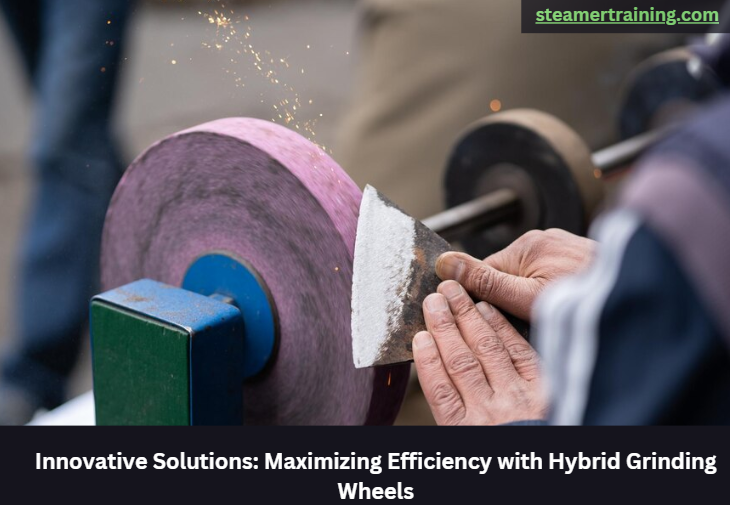Hybrid grinding wheels have emerged as revolutionary solutions in modern grinding technology, dramatically changing how material removal and surface finishing processes take place. By combining various abrasive materials and bonding systems together to form one comprehensive wheel system, hybrid grinding wheels offer unparalleled performance, efficiency, and versatility across numerous industrial applications. In this comprehensive guide we will examine hybrid grinding wheels‘ unique characteristics, manufacturing process, applications and associated benefits brought about by modern machining/manufacturing operations.
Understanding Hybrid Grinding Wheels
Hybrid grinding wheels represent an innovative development in grinding technology, fusing together various abrasive materials and bonding systems to produce maximum performance and versatility. Here we explore their inner workings – their composition, production process and advantages offered to modern manufacturing operations.
The Concept of Hybridization
Hybrid grinding wheels represent an integration of various abrasive materials and bonding systems designed to complement each other and maximize their individual advantages. By using multiple grains with various bond types to form hybrid wheels, these aim to optimize grinding performance, achieve superior surface finishes, and extend tool life for diverse machining applications.
Composition and Construction
Hybrid grinding wheels typically consist of an array of abrasive grains such as aluminum oxide, silicon carbide and diamond combined with resin-, vitrified- or metal bonds for bonding systems. Their exact composition and construction vary according to application requirements and performance objectives, though hybridization processes generally consist of mixing various combinations of material types together in controlled proportions before molding and sintering in order to form cohesive grinding wheel structures.
Advantages of Hybrid Grinding Wheels
Hybrid grinding wheels have quickly emerged as innovative tools in modern machining and manufacturing, thanks to a unique fusion of cutting-edge materials and revolutionary design principles. Hybrid wheels offer unparalleled advantages over their counterparts such as enhanced performance and versatility; longer tool lifespan; superior surface finishes. Let us delve into all these benefits, which have revolutionized modern machining and manufacturing environments.
Enhanced Performance
Hybrid Grinding Wheels Offer Superior Performance Hybrid grinding wheels deliver enhanced performance compared to their conventional counterparts due to the unique blend of abrasive materials and bonding systems they feature. Utilizing different grains allows for optimized material removal rates, reduced grinding forces and superior surface finishes; ultimately resulting in increased productivity and efficiency when performing machining operations.
Versatility
Among the key benefits of hybrid grinding wheels is the versatility across an array of materials and applications. Be it grinding hard metals, soft alloys, or non-metallic materials, hybrid wheels stand out in delivering consistent results and looking after dimensional precision and surface integrity. This versatility means they are appropriate to be used in industries for example aerospace, automotive, oral appliance die, and medical manufacturing, in which a diverse selection of materials should be machined to exacting specifications
Extended Tool Life
Hybrid grinding wheels are engineered to maximise tool existence and reduce the requirement for frequent wheel changes, leading to financial savings and elevated operational efficiency. The mixture of various abrasive materials and connecting systems enhances wheel durability and potential to deal with put on, making certain prolonged performance and consistent grinding results with time. This extended tool existence means reduced downtime and maintenance costs, making hybrid wheels an expense-effective solution for top-volume machining operations.
Improved Surface Finishes
Using their unique composition and construction, hybrid grinding wheels can handle producing superior coatings with minimal surface roughness and waviness. The enhanced distribution of abrasive grains and connecting materials ensures uniform material removal and reduced surface defects, leading to parts with precise geometries and-quality coatings. This enhanced surface quality is crucial in industries for example aerospace, automotive, and electronics manufacturing, where tight tolerances and fine surface finishes are crucial for product performance and reliability.
Applications of Hybrid Grinding Wheels
Hybrid grinding wheels have transformed the way you approach material removal and surface finishing across an assorted selection of industries. Using their unparalleled versatility, precision, and efficiency, these innovative wheels find extensive use within applications varying from precision grinding to heavy-duty material removal. Let us explore the myriad applying hybrid grinding wheels and just how they lead to enhancing productivity and quality in modern machining and manufacturing operations.
Precision Grinding
Hybrid grinding wheels are broadly utilized in precision grinding applications that need tight tolerances, fine coatings, and dimensional precision. They’re generally used in producing aerospace components, automotive parts, and medical devices, where high-quality coatings and precise geometries are crucial for component performance and functionality.
Tool and Cutter Grinding
Within the oral appliance cutter grinding industry, hybrid wheels are crucial for sharpening and reconditioning cutting tools for example drills, finish mills, and inserts. Remarkable ability to keep sharp cutting edges and convey consistent coatings ensures optimal tool performance and extended tool existence in machining operations.
Surface Grinding
Hybrid grinding wheels find extensive use within surface grinding applications, where flatness, parallelism, and surface finish are key needs. They operate in surface grinding machines to grind flat surfaces, for example machine beds, bearing surfaces, and work surface faces, rich in precision and efficiency.
Cylindrical Grinding
In round grinding operations, hybrid wheels are employed for grinding round workpieces to specific diameters, lengths, and coatings. They’re generally utilized in producing shafts, pins, rollers, and cylinders, where dimensional precision and surface integrity are very important for component performance and functionality.
Conclusion
Hybrid grinding wheels represent a paradigm transfer of grinding technology, offering unmatched performance, efficiency, and flexibility in modern machining and manufacturing operations. Their own composition, construction, and gratifaction characteristics make sure they are indispensable tools for achieving precision grinding, surface finishing, and material removal in an array of industries and applications. Using their capability to combine the benefits of different abrasive materials and connecting systems, hybrid grinding wheels create enhanced productivity, financial savings, and good quality in machining operations. Because the interest in greater efficiency and tighter tolerances keeps rising, hybrid grinding wheels stand poised to guide the means by shaping the way forward for grinding technology and driving innovation in modern manufacturing.
